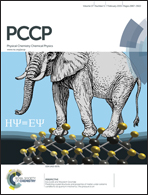Resonance Raman detection of the myoglobin nitrito heme Fe–O–N![[double bond, length as m-dash]](https://www.rsc.org/images/entities/char_e001.gif) O/2-nitrovinyl species: implications for helix E-helix F interactions
O/2-nitrovinyl species: implications for helix E-helix F interactions
Abstract
The description of biological activity in heme proteins responsible for activating small molecules requires identification of ligand movement into the metal and non-metal binding sites. Mechanisms of nitrite reductase activity in globins are difficult to verify without the structures of the bound ligand, but we now have such information from resonance Raman spectroscopy on the myoglobin nitrito heme Fe–O–N![[double bond, length as m-dash]](https://www.rsc.org/images/entities/char_e001.gif) O/2-nitrovinyl species in their natural environment rather than in crystals. Our results indicate that the formation of the nitrito heme Fe–O–N
O/2-nitrovinyl species in their natural environment rather than in crystals. Our results indicate that the formation of the nitrito heme Fe–O–N![[double bond, length as m-dash]](https://www.rsc.org/images/entities/char_e001.gif) O/2-nitrovinyl species is pH-dependent. The conditions under which the nitrito heme Fe–O–N
O/2-nitrovinyl species is pH-dependent. The conditions under which the nitrito heme Fe–O–N![[double bond, length as m-dash]](https://www.rsc.org/images/entities/char_e001.gif) O/2-nitrovinyl species is generated strongly suggest that this form corresponds to an acid induced transformation. We propose that the movement of helices E and F at low pH results in the protonation of nitrito heme Fe–O–N
O/2-nitrovinyl species is generated strongly suggest that this form corresponds to an acid induced transformation. We propose that the movement of helices E and F at low pH results in the protonation of nitrito heme Fe–O–N![[double bond, length as m-dash]](https://www.rsc.org/images/entities/char_e001.gif) O by His64 Nε–H(E) to form the nitrous heme Fe–O(H)–N
O by His64 Nε–H(E) to form the nitrous heme Fe–O(H)–N![[double bond, length as m-dash]](https://www.rsc.org/images/entities/char_e001.gif) O species.
O species.
![Graphical abstract: Resonance Raman detection of the myoglobin nitrito heme Fe–O–N [[double bond, length as m-dash]] O/2-nitrovinyl species: implications for helix E-helix F interactions](/en/Image/Get?imageInfo.ImageType=GA&imageInfo.ImageIdentifier.ManuscriptID=C4CP04352A&imageInfo.ImageIdentifier.Year=2015)

 Please wait while we load your content...
Please wait while we load your content...
![[double bond, length as m-dash]](https://www.rsc.org/images/entities/h2_char_e001.gif) O/2-nitrovinyl species: implications for helix E-helix F interactions
O/2-nitrovinyl species: implications for helix E-helix F interactions